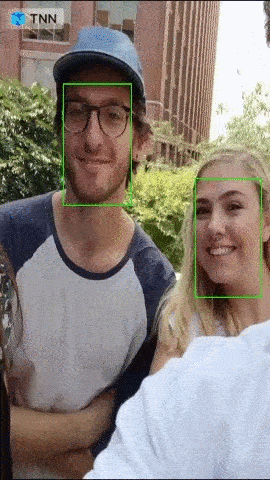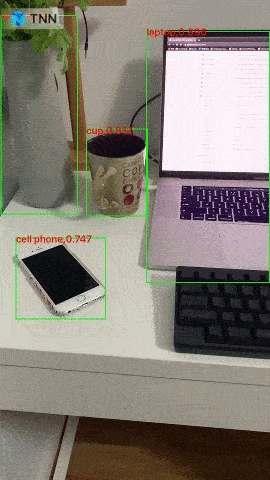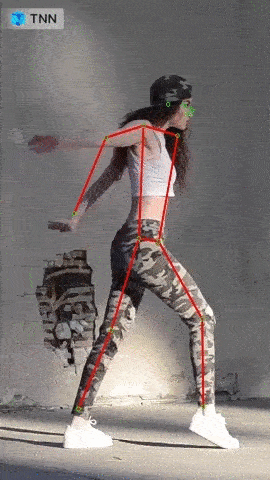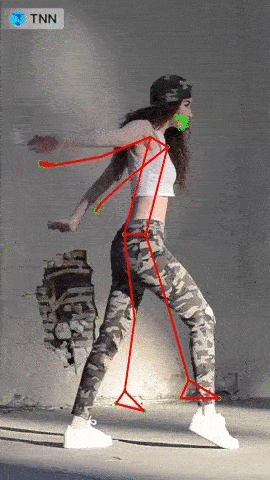
TNN is a high-performance and lightweight inference framework for mobile devices. It provides lots of advanced features such as cross-platform, model-compression, and code-pruning. TNN, inspired by mainstream open-source industry frameworks, integrates and leverages Youtu Lab's Rapidnet, ncnn framework. It also combines the efforts of the deep-learning framework Oteam from all departments(PCG, TEG, IEG) to create an enterprise-level mobile inference engine. At present, TNN has been launched to support various products in Youtu Lab and Guangying Studio.
| Face Detection(blazeface) | Object Detection(yolov5s) | Face Alignment (from Tencent Youtu Lab) |
|---|---|---|
 iOS ✅ Android ✅ model link |
 iOS ✅ Android ✅ model link |
 iOS ✅ Android ✅ model link |
| Hair Segmentation (from Tencent Guangying Lab) |
Pose Estimation (from Tencent Guangliu) |
Pose Estimation(blazepose) |
 iOS ✅ Android ✅ model link |
 iOS ✅ Android ✅ model link |
 iOS ✅ Android ✅ model link |
It is very simple to use TNN. If you have a trained model, the model can be deployed on the target platform through three steps.
-
Convert the trained model into a TNN model. We provide a wealth of tools to help you complete this step, whether you are using Tensorflow, Pytorch, or Caffe, you can easily complete the conversion. Detailed hands-on tutorials can be found here How to Create a TNN Model.
-
When you have finished converting the model, the second step is to compile the TNN engine of the target platform. You can choose among different acceleration solutions such as ARM/OpenCL/Metal/NPU according to the hardware support. For these platforms, TNN provides convenient one-click scripts to compile. For detailed steps, please refer to How to Compile TNN.
-
The final step is to use the compiled TNN engine for inference. You can make program calls to TNN inside your application. We provide a rich and detailed demo as a reference to help you complete.
TNN is a high-performance and lightweight inference framework for mobile devices. It provides lots of advanced features such as cross-platform, model-compression, and code-pruning. TNN, inspired by mainstream open-source industry frameworks, integrates and leverages Youtu Lab's Rapidnet, ncnn framework. It also combines the efforts of the deep-learning framework Oteam from all departments(PCG, TEG, IEG) to create an enterprise-level mobile inference engine. At present, TNN has been launched in various major businesses, and its following characteristics have been widely praised.
-
Computation optimization
- The backend operators are primely optimized to make the best use of computing power in different architectures, regarding instruction issue, throughput, delay, cache bandwidth, cache delay, registers, etc..
- The TNN performance on mainstream hardware platforms (CPU: ARMv7, ARMv8, GPU: Mali, Adreno, Apple) has been greatly tuned and improved.
- The convolution function is implemented by various algorithms such as Winograd, Tile-GEMM, Direct Conv, etc., to ensure efficiency under different parameters and sizes.
- Op fusion: TNN can do offline analysis of network graph, fuse multiple simple operations and reduce overhead such as redundant memory access and kernel startup cost.
-
Low precision computation acceleration
- TNN supports INT8/FP16 mode, reduces model size & memory consumption, and utilizes specific hardware low-precision instructions to accelerate calculations.
- TNN supports INT8 WINOGRAD algorithm, (input 6bit), further reduces the model calculation complexity without sacrificing the accuracy.
- TNN supports mixed-precision data in one model, speeding up the model's calculation speed while preserving its accuracy.
-
Memory optimization
- Efficient "memory pool" implementation: Based on a full network DAG analysis, the implementation reuses memory between non-dependent nodes which reduces memory cost by 90%.
- Cross-model memory reduces: This supports external real-time design for network memory so that multiple models can share mutual memory.
-
The performance of mainstream models on TNN: v0.1 2020.05.29
-
Kirin970:
model cpu time(single thread, ms) gpu time(ms) Mobilenet_v1 88 12 Mobilenet_v1_int8 55 Mobilenet_v2 58 11 Mobilenet_v2_int8 41 squeezenet_v1.0 127 20 squeezenet_v1.0_int8 82 -
Snapdragon 835:
model cpu time(single thread, ms) gpu time(ms) Mobilenet_v1 94 16 Mobilenet_v1_int8 62 Mobilenet_v2 61 14 Mobilenet_v2_int8 47 squeezenet_v1.0 122 28 squeezenet_v1.0_int8 93 -
Snapdragon 845:
model cpu time(single thread, ms) gpu time(ms) Mobilenet_v1 60 10 Mobilenet_v1_int8 37 Mobilenet_v2 39 8 Mobilenet_v2_int8 28 squeezenet_v1.0 74 14 squeezenet_v1.0_int8 56
-
-
TNN architecture diagram:
-
TNN supports TensorFlow, Pytorch, MxNet, Caffe, and other training frameworks through ONNX, leveraging the continuous improvement of the ONNX open-source society. Currently, TNN supports 55 ONNX operators and will be developed to cover 80 operators shortly, consisting of most of the mainstream CNN operators needed.
-
TNN runs on mainstream operating systems (Android, iOS, embedded Linux), and is compatible with ARM CPU, GPU hardware platform (Da Vinci NPU will be supported soon)
-
TNN is constructed through Modular Design, which abstracts and isolates components such as model analysis, graph construction, graph optimization, low-level hardware adaptation, and high-performance kernel. It uses "Factory Mode" to register and build devices, that tries to minimize the cost of supporting more hardware and acceleration solutions.
-
TNN's running time does not rely on any third-party libraries. The size of the CPU dynamic library is only around 400KB, and it provides basic image conversion operations, which are light-weight and convenient. TNN uses unified models and interfaces across platforms and can switch easily by configuring just one single parameter.
TNN referenced the following projects:
-
Everyone is welcome to participate to build the best mobile inference framework in the industry.
-
Technical Discussion QQ Group: 913940506 Answer: TNN
-
Scan the QR code to join the TNN discussion group:

